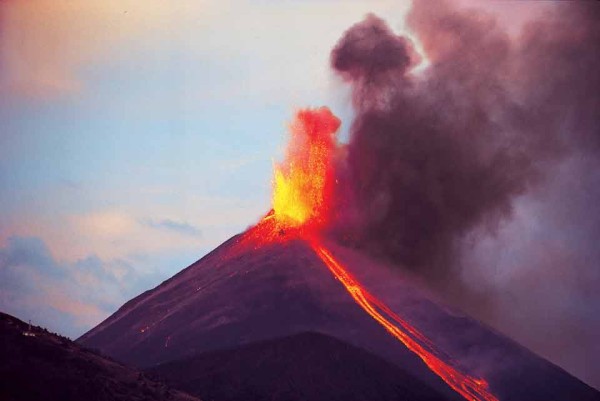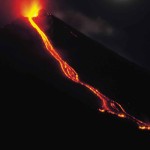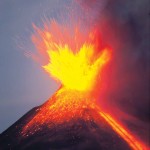Panic on Pacaya

Pacaya looked like an immense Roman candle as the lava shot more than one kilometer into the firmament and a deep, ultra-low frequency roar emanated from the trembling ground below our feet.
The entire Pacific Ocean basin is fringed by hundreds of volcanoes, most extinct and inactive, but some frequently belching incandescent molten lava. One of the most tectonically active zones on Earth is found in northern Central America where, according to current geologic theory, three crustal plates collide. Where the Pacific Plate subducts down into the Earth’s mantle beneath the Continental Plate we find volcanoes, nearly always located about 10 miles inland from the ocean shore.
Guatemala is particularly blessed by these immense conical peaks and dozens of them line up along the eastern edge of the Pacific coastal plain. Three of these cones are considered active: Santiaguito, Fuego and Pacaya, while others, like Atitlán, are considered semi-active due to the presence of steam-emitting fumaroles.
Lake Atitlán itself is located in a gigantic volcanic crustal collapse or caldera. Many years ago I lived in a little cantón adjacent to San Lucas Tolimán on Lake Atitlán’s southern shore. We decided to dig a well. When we reached the depth of about 12 feet we were astounded to find pottery shards. It must have been a truly cataclysmic eruption to have buried these artifacts under so much lava and ash! No doubt about it, Guatemala is justifiably known as “the land of shake and bake!”
January 1987
Guatemala’s largest and most spectacular volcanic eruption in living memory took place in 1987. As it happened, I had been watching volcán Pacaya for several weeks and noticed that the eruptions were getting stronger and stronger. One January day I decided that it would be a good time to drive to the upper slopes of the cone to get some images for my photo archives. My partner Magalí and I drove right up to the lava fields on a little dirt track out from the village of San Vicente Pacaya. From this vantage point we had a spectacular view of the bubbling caldron of incandescent lava.
We arrived at mid-afternoon as the fiery emissions were spewing 100 meters into the sky. The view we had was impressive, nearly perfect, and I set up my equipment with the idea of waiting until dusk when the conditions would be ideal. As the afternoon wore on the volcano increased in activity and the eruptions became steadily higher and more frequent.
By 5pm the thundering ejections were taking place every 20-30 seconds and were reaching several hundred meters in height. As dusk approached the eruptions were closer together and the noise of the periodic, deafening explosions made us very nervous.
By now vehicles were racing by as terrified residents from the little town of Caracol fled the scene to seek refuge down below in the town of Amatitlán. I continued to snap away egged on by the certainty that I was getting some world-class images of one of nature›s most dazzlingly sublime shows. Nothing can compare to the glorious power of Mother Nature when she decides to show us her stuff.
Magalí was screaming over the din that we needed to get out of there NOW! Procrastinating, I continued to snap away, hoping to get that perfect shot. Right at nightfall all hell broke loose. Pacaya looked like an immense Roman candle as the lava shot more than one kilometer into the firmament and a deep, ultra-low frequency roar emanated from the trembling ground below our feet.
A terrible sound the likes of which I have never heard before or since. Powder-fine incandescent ash rained down upon us and singed the hair on my arms. Magalí dashed for the car, threw it into reverse to turn it around, and got it hopelessly stuck in the ash along the side of the road.
Our means of escape was gone and in an instant our prospects turned grim. Fear gripped my heart. We were going to have to abandon everything and run for our lives. Just then the last straggler from Caracol careened around the bend, and, seeing our plight, the men rushed to push our car onto the road again.
We drove full speed down and down the seemingly endless switchbacks with the ominous eerily orange glow filling the sky behind us. One of my fondest memories is of the cold beers we drank that night marveling at what we had just experienced; almost being carbonized in Pacaya’s fiery maelstrom.
February 2000
We were all exhausted after a long day exploring the coast near Retalhuleu searching for undiscovered shamanic temples to document. I noticed an orange glow way off in the distant sky. Was it possible that I was seeing Pacaya erupting nearly 100 kilometers away? Sure enough, more than an hour later as we left Escuintla we caught an amazing view of the unusual fiery display. It was late and we were tired, but I convinced my companions that we should drive up closer. “I know a good spot where I got some great photos years ago,” I said. Up and up we drove.
From the area around San Vicente the view of Pacaya was superb. We continued on toward the lava field. We expected to meet other volcano watchers up there but the place was abandoned. The eruptions were getting higher and the full moon was out.
One of my companions, Joe, wanted to continue to drive around Pacaya. I warned that I had no knowledge of road conditions but he insisted. As we passed through the village of Caracol there was not a person in sight. I warned again that I did not think it was safe to continue. We ended up on the road down to hell!
The eruptions were getting stronger and now we were stuck on the south side of the cone—historically the worst place to be, where most of Pacaya’s victims have lost their lives. It was obvious to me that the slope we were stuck on had been recently blanketed with thick, black ash. The fumes from the volcano were beginning to make me feel woozy.
“Isn’t that river of lava starting to head our way,” stuttered another companion, Maya Jean. Joe tried his cell phone praying for a bailout. Dead! He want back up the trail to look for help. The rest of us were getting ready to abandon the vehicle and make our way down the slope the best we could.
As fate would have it Joe returned half an hour later with two residents who had not abandoned Caracol. They told us that there was a way out and proceeded to guide us down a series of gullies and seemingly invisible trails that led to safety. It had been one beautiful, scary, intense night!
Ed note: The intention of this article is, in no way, meant to encourage readers to attempt similar feats.

